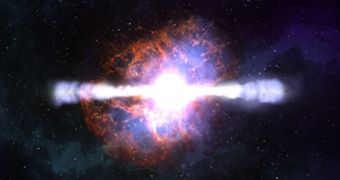There are very few massive stars in the Universe, proportionately compared with the number of smaller ones. The former live short, troubled lives, burning up their fuel very fast – within several millions of years. When they reach the end of their burning cycle, they explode in huge blasts that are so intense, that they can briefly outshine entire galaxies. One of the main reasons for this is the fact that gamma-ray bursts (GRB) are formed and emitted.
The source of the highly energetic radiation has remained somewhat of a mystery for astrophysicists, and massive stellar explosions seem like some of the few models that could actually account for the energy that the photons in such bursts have. Scientists were recently able to conclude that one of the main “culprits” behind these incredibly powerful explosions and gamma-ray bursts (GRB) were magnetic fields. This was very difficult because no group had been able to determine the existence of such fields in GRB until now.
The breakthrough came on January 2, when the Swift satellite, a scientific observatory operated by the American space agency NASA, detected a GRB eruption. The detector spends its time in orbit scanning the Universe continuously, looking for gamma-rays. When it detects them, it immediately sends signals to telescopes back on Earth to join in on the fun. In this case, the one to answer was the robotic Liverpool Telescope, located in the Canary Island of La Palma, Spain. It started observing the GRB automatically as soon as it received the Swift signal.
What really made the discovery possible was the fact that the telescope had been outfitted with a filter able to detect polarized light. This is light that features photons that are electrically and magnetically aligned in a certain direction. While investigating the GRB signature, the filter was able to detect polarized light inside the radiation, which means that the latter must have originated within strong magnetic fields. “This breakthrough observation gives us the first measurement of magnetic fields in the afterglow of a GRB,” Neil Gehrels, the Swift lead scientist, explained at the time. He is based at the NASA Goddard Space Flight Center, in Greenbelt, Maryland.
“This is a first indication that magnetic fields are very important [in GRB]. I think this is a good step forward to understanding the energetics in the jet and the role of magnetic fields,” astronomer Iain Steele, the Liverpool Telescope director, told Space. The expert, who is also a Liverpool John Moores University professor, was the leader of a team that published a detailed account of the GRB observations, in the December 10 issue of the highly respected scientific journal Nature.

 14 DAY TRIAL //
14 DAY TRIAL //